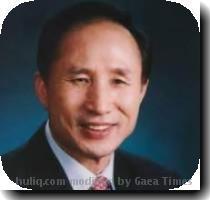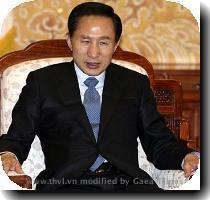Tearful SKorean president vows strong action against masterminds of deadly ship sinking
By Hyung-jin Kim, APMonday, April 19, 2010
SKorea’s Lee vows strong action in ship sinking
SEOUL, South Korea — An emotional President Lee Myung-bak vowed Monday that South Korea would respond “resolutely and unwaveringly” against those behind the deadly sinking of a naval ship near the tense maritime border with North Korea.
Seoul has not openly blamed Pyongyang for the March 26 explosion that broke the 1,200-ton Cheonan in two during a routine patrol, killing at least 38 of the 104 sailors on board.
However, officials said they were investigating the possibility that a North Korean naval mine or torpedo may have struck the warship, which went down in Yellow Sea waters where the rival Koreas have clashed three times in the past decade.
The two Koreas remain in a state of war because their 1950-53 conflict ended in a cease-fire, not a peace treaty. North Korea disputes the maritime border drawn by the United Nations at the close of the fighting.
North Korea denied any involvement Saturday and accused the South of spreading false rumors.
The president did not mention North Korea in his address but vowed to deal “resolutely and unwaveringly” with the outcome of the investigation. He pledged to build a stronger military to ensure such an incident never happens again.
“I promise you that as president, I will uncover the cause of the Cheonan’s sinking down to the very last detail,” Lee said in the 10-minute televised speech.
Wiping away tears with a handkerchief, he read out the names of all the dead and missing sailors. The disaster is among the worst in South Korea’s naval history.
“The country that you loved will never forget any of you,” he said.
Speculation of North Korean involvement in the blast has mounted since the chief investigator said Friday, after an initial examination of the wreckage, that an external explosion appeared likely. He said it was less likely that munitions stored in the warship or a collision caused the disaster.
A torpedo or mine are among suspected culprits.
“Both are possible, but I think the likelihood of a torpedo is more substantial,” Defense Minister Kim Tae-young told lawmakers last week.
He also has said the ship may have been struck by a mine left over from the war, or even deliberately dispatched from the North. North Korea has removed some but not all the 3,000 Soviet-made naval mines the regime planted in the waters off both coasts during the war, he said.
Kim, however, has said there has been no definitive evidence showing North Korea’s involvement. He acknowledged during a parliamentary committee meeting Monday that survivors have testified their sonar didn’t detect any signs of an approaching torpedo, there was no smell of gunpowder and columns of water were not detected at the time of the blast.
The Joint Chiefs of Staff said Monday that no shrapnel of a torpedo or a naval mine has been retrieved from the area yet.
A military commentator quoted in North Korea’s state media accused Seoul of seeking to shore up sanctions against the North and to muster conservative votes for upcoming mayoral and gubernatorial elections.
The U.N. Security Council tightened sanctions against North Korea after the regime carried out a nuclear test last year.
South Korea’s foreign minister said Seoul would take the issue to the Security Council if North Korea emerges as the culprit behind the sinking of the Cheonan.
Foreign Minister Yu Myung-hwan said it was too early to determine the cause but that the government was bracing for all possible outcomes.
Tags: Accidents, Asia, East Asia, Koreas, Lee Myung-bak, North Korea, Seoul, South Korea, Transportation



